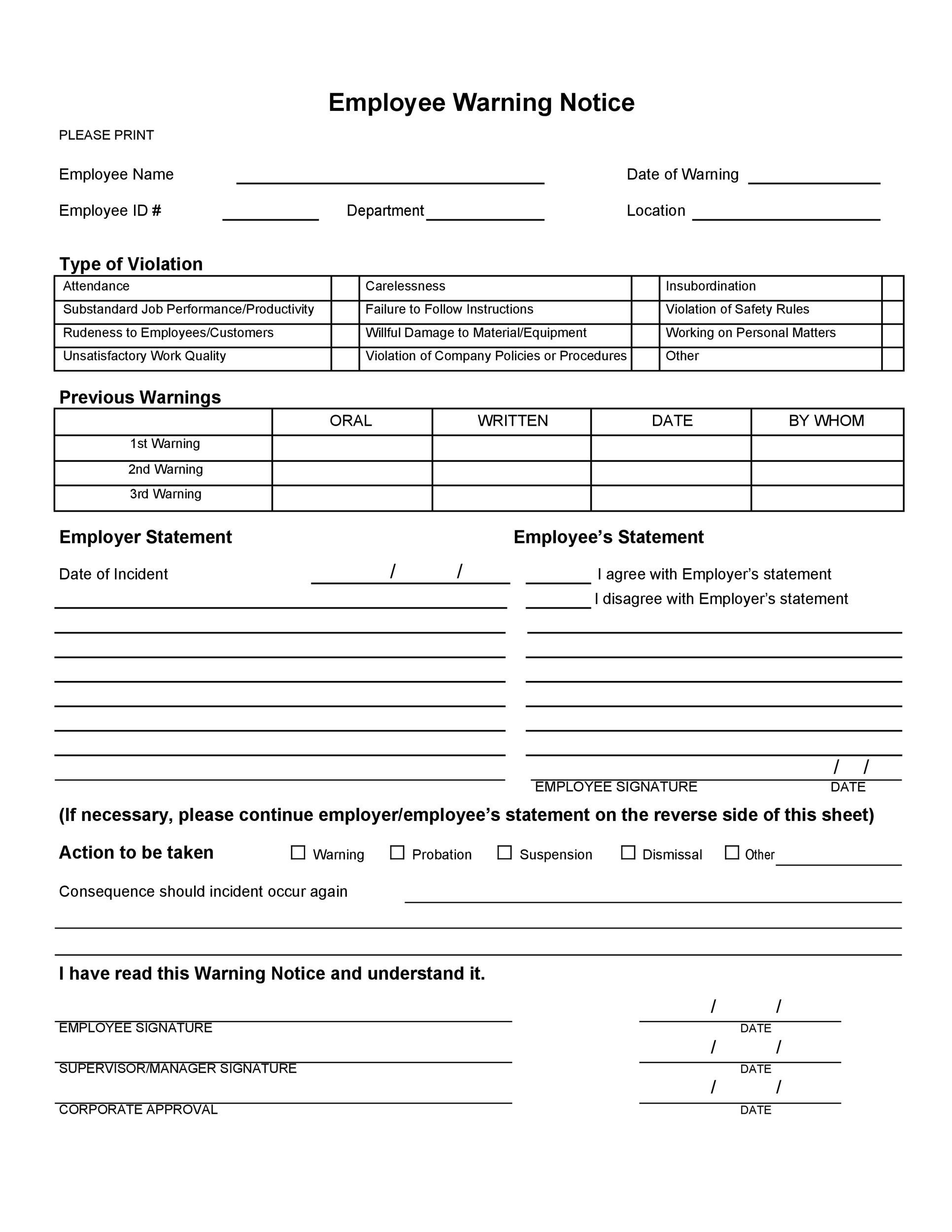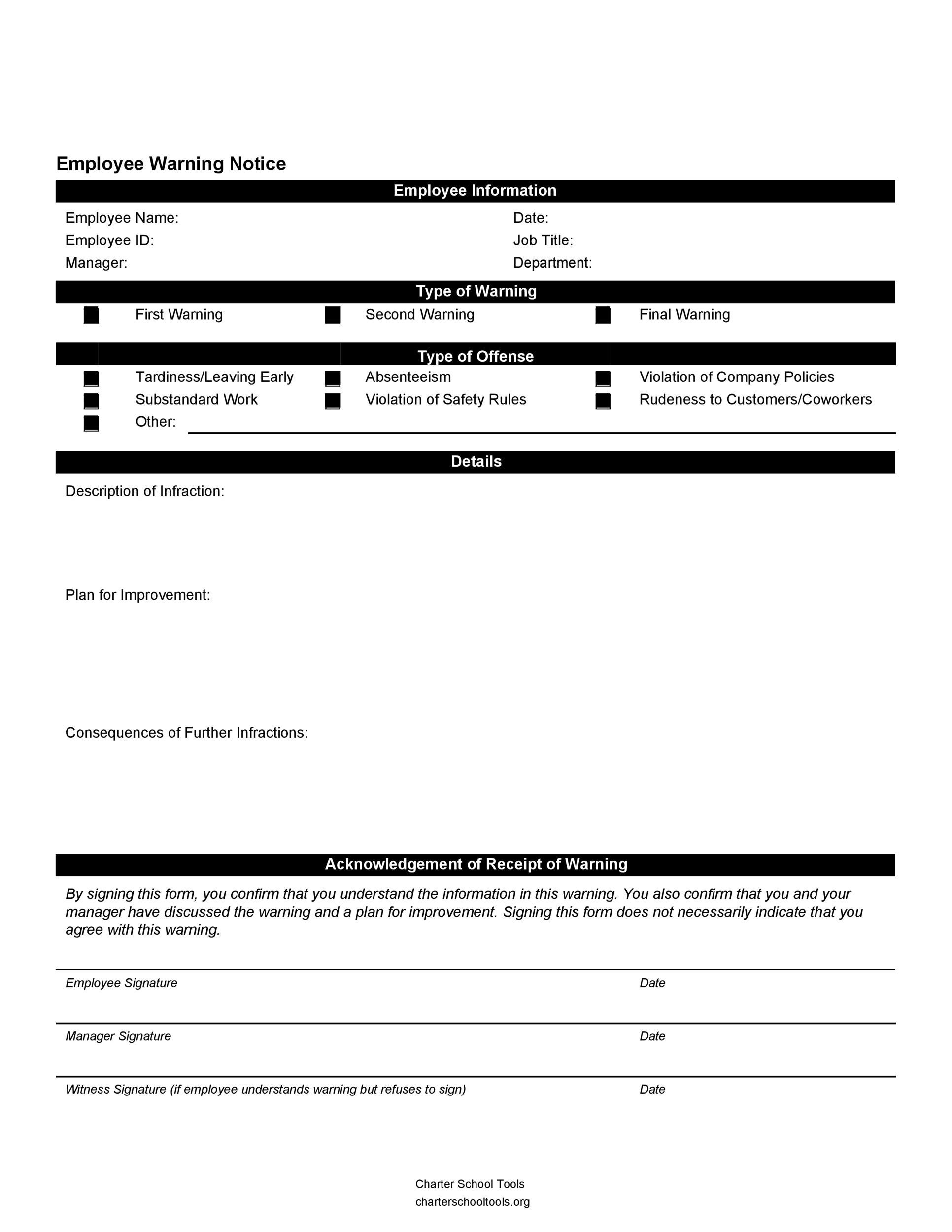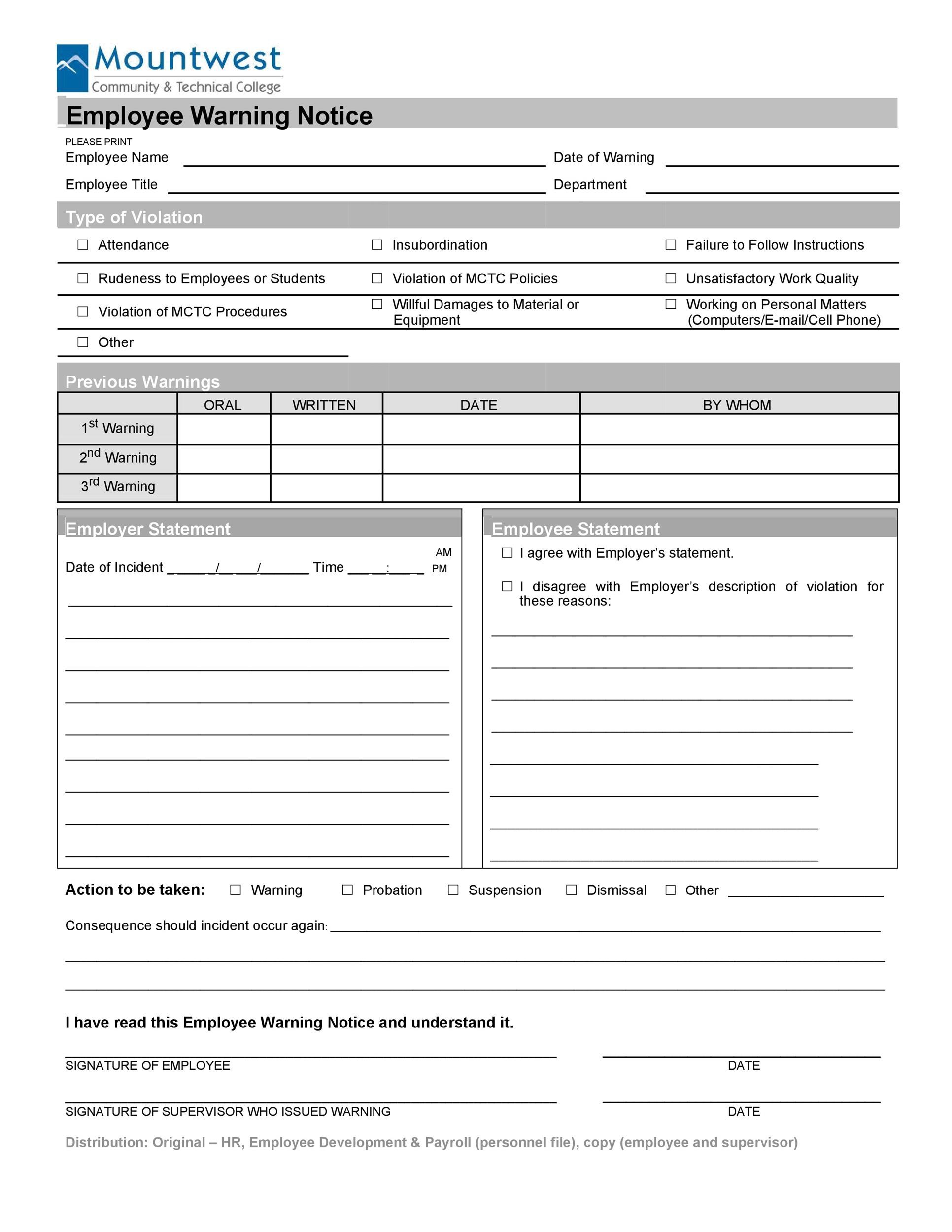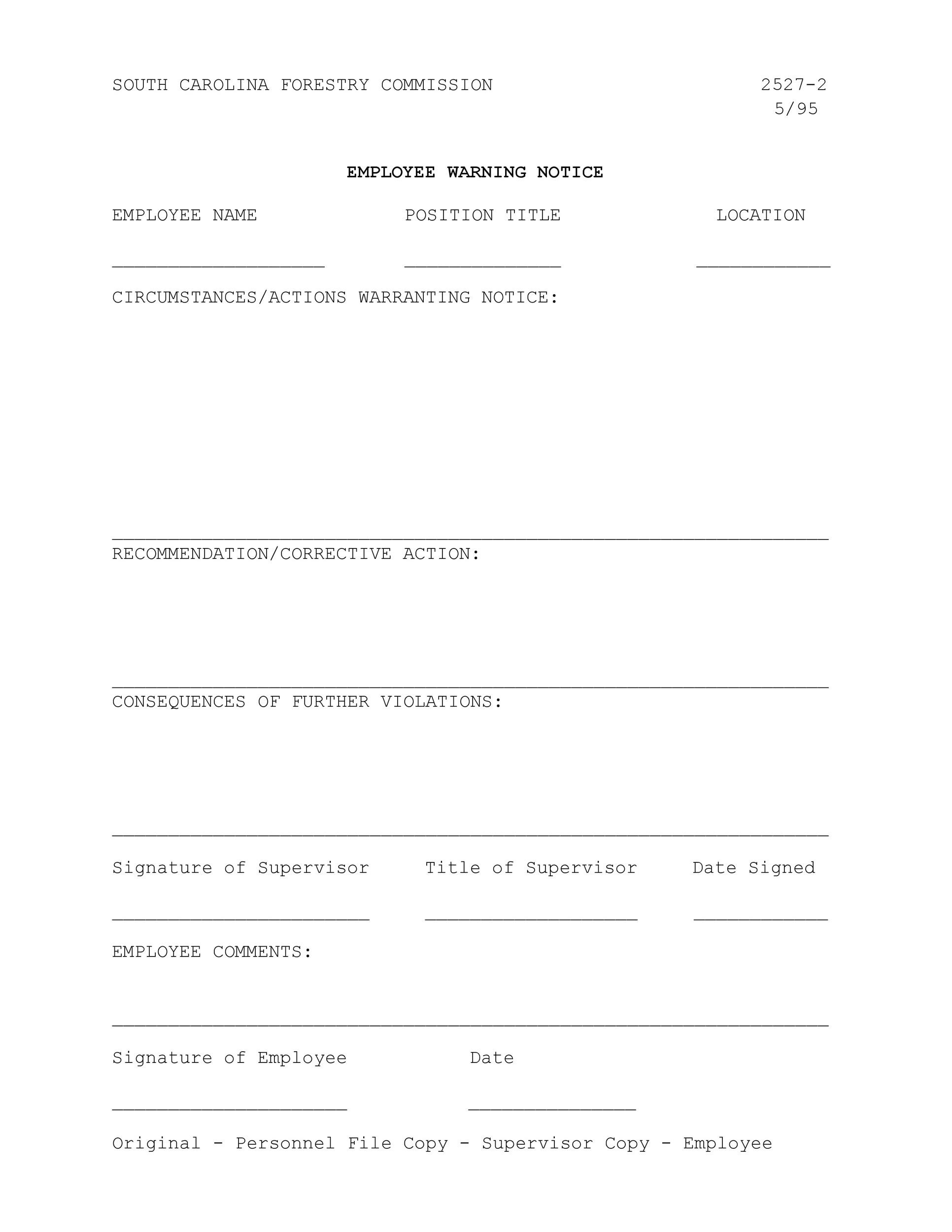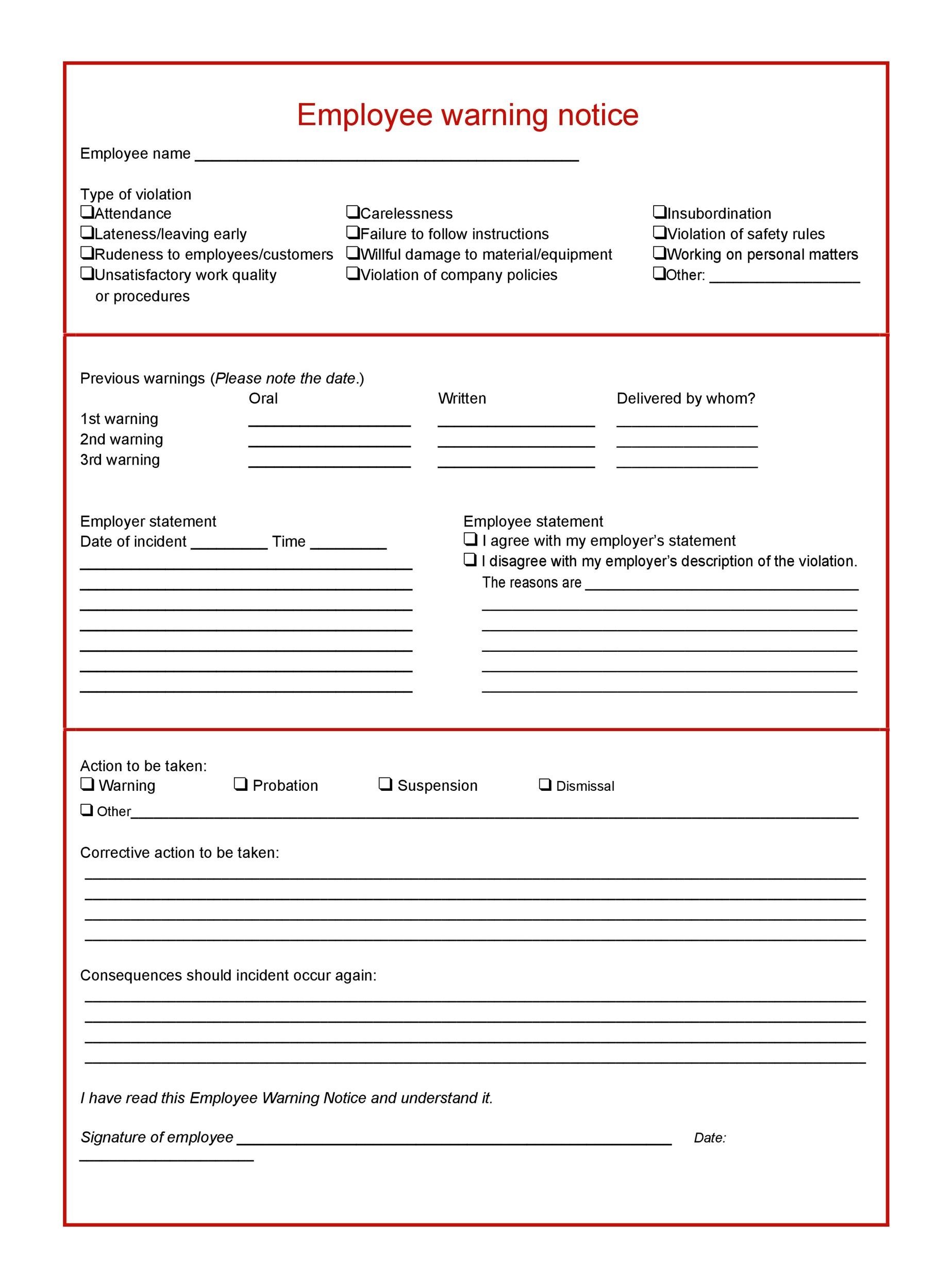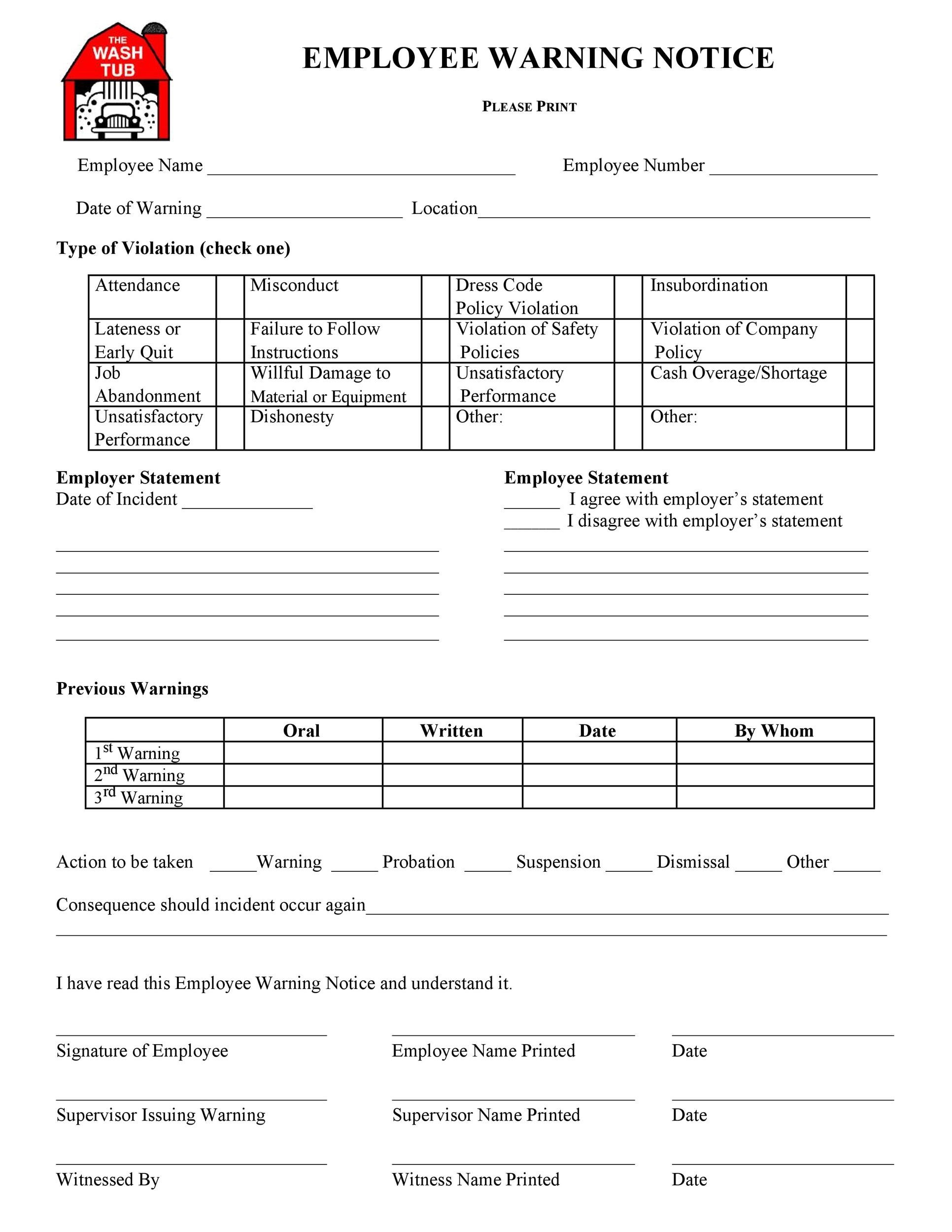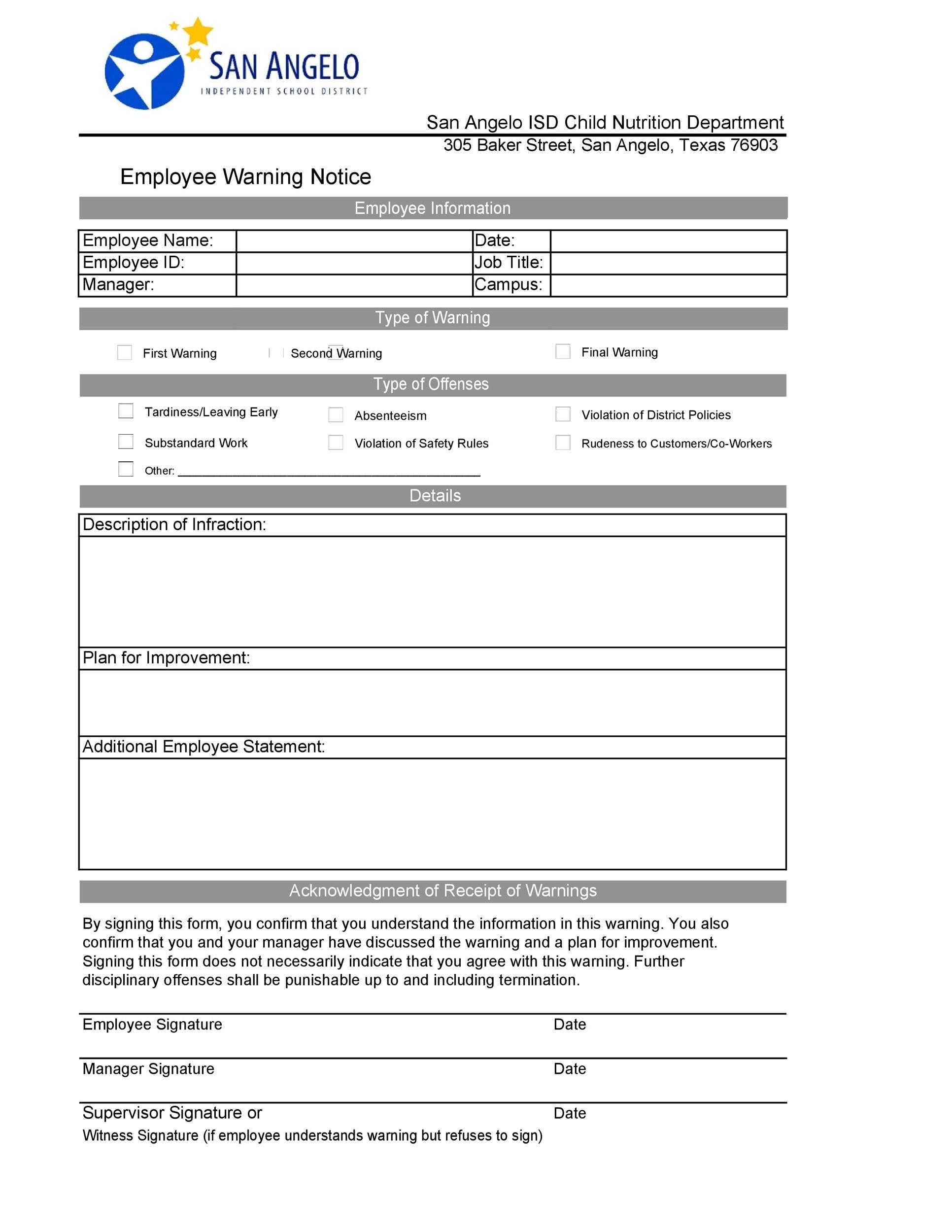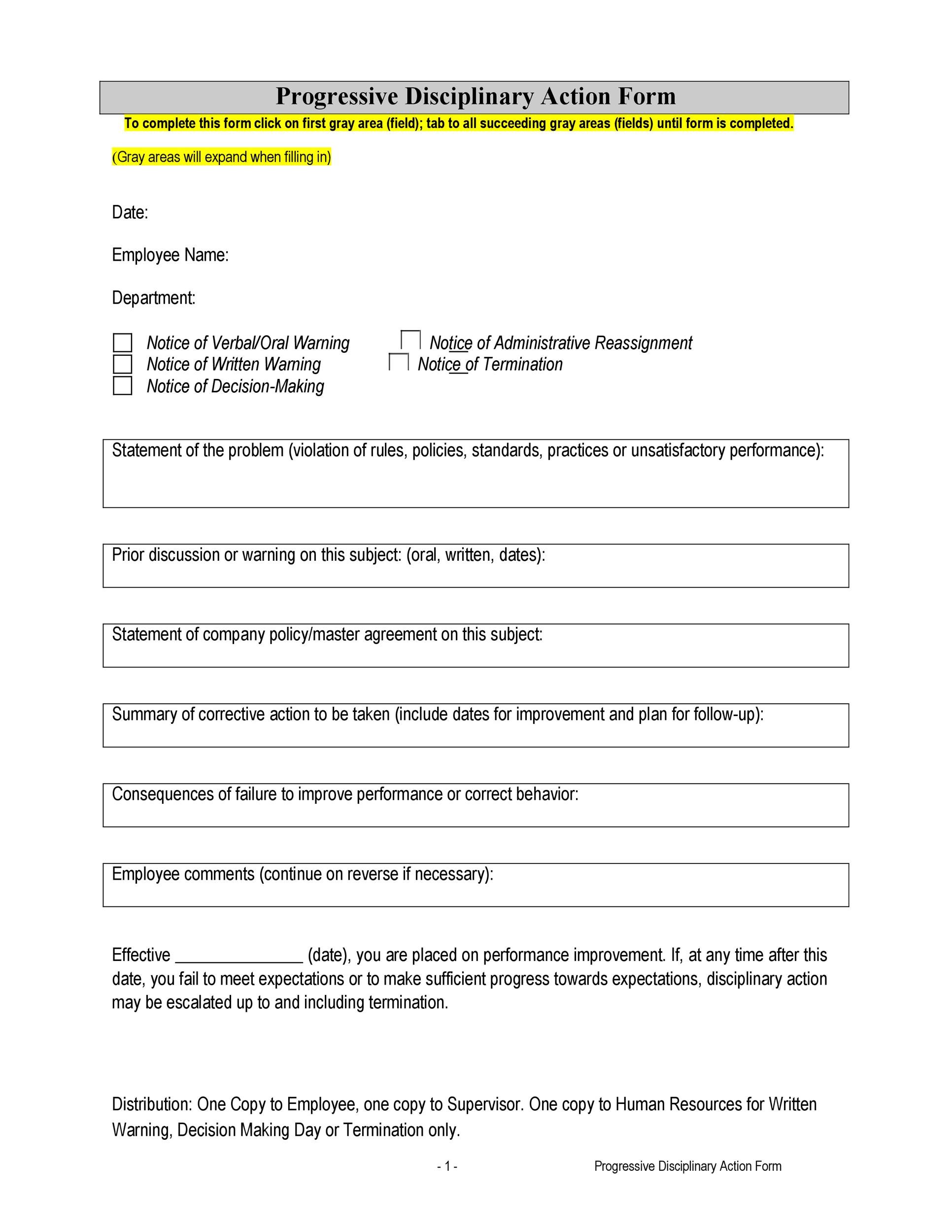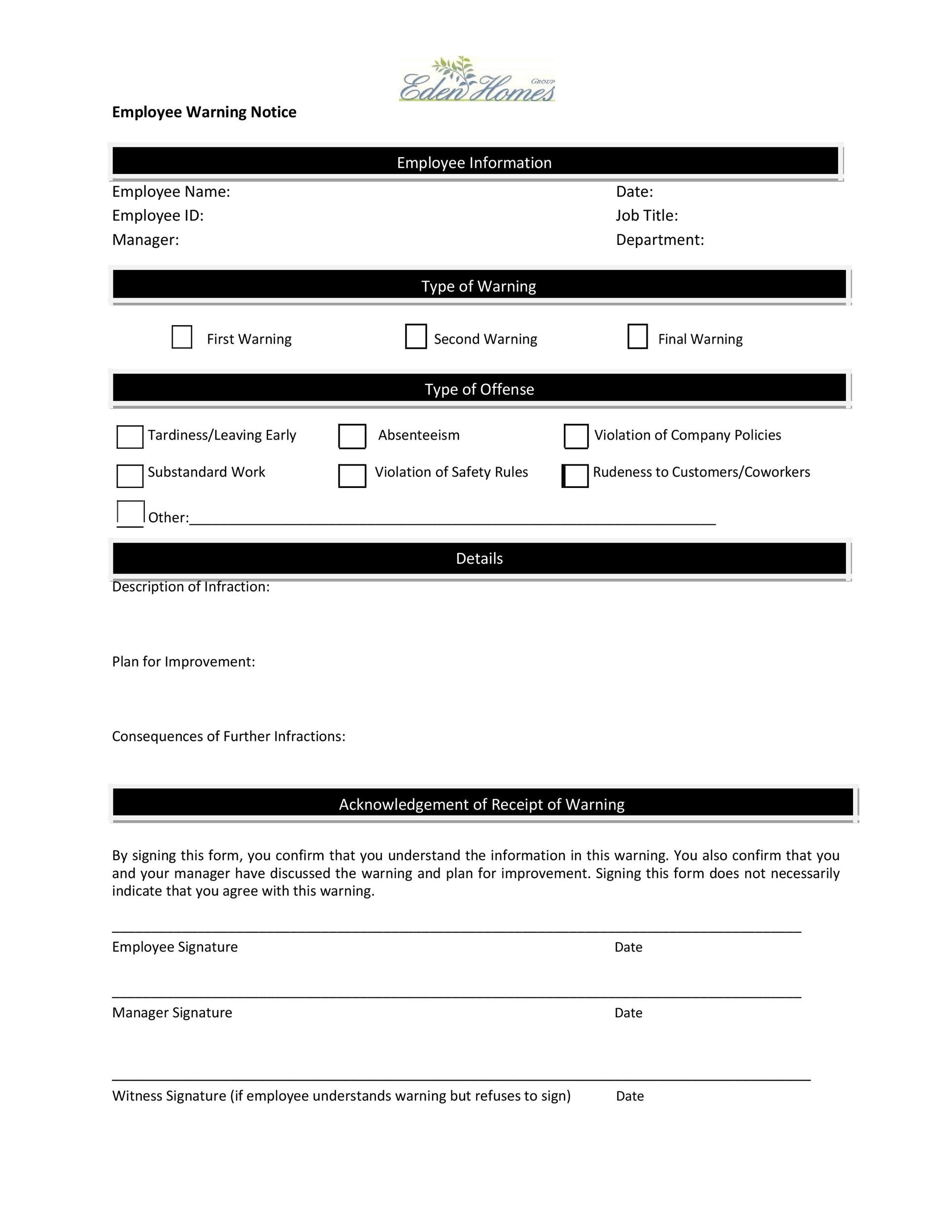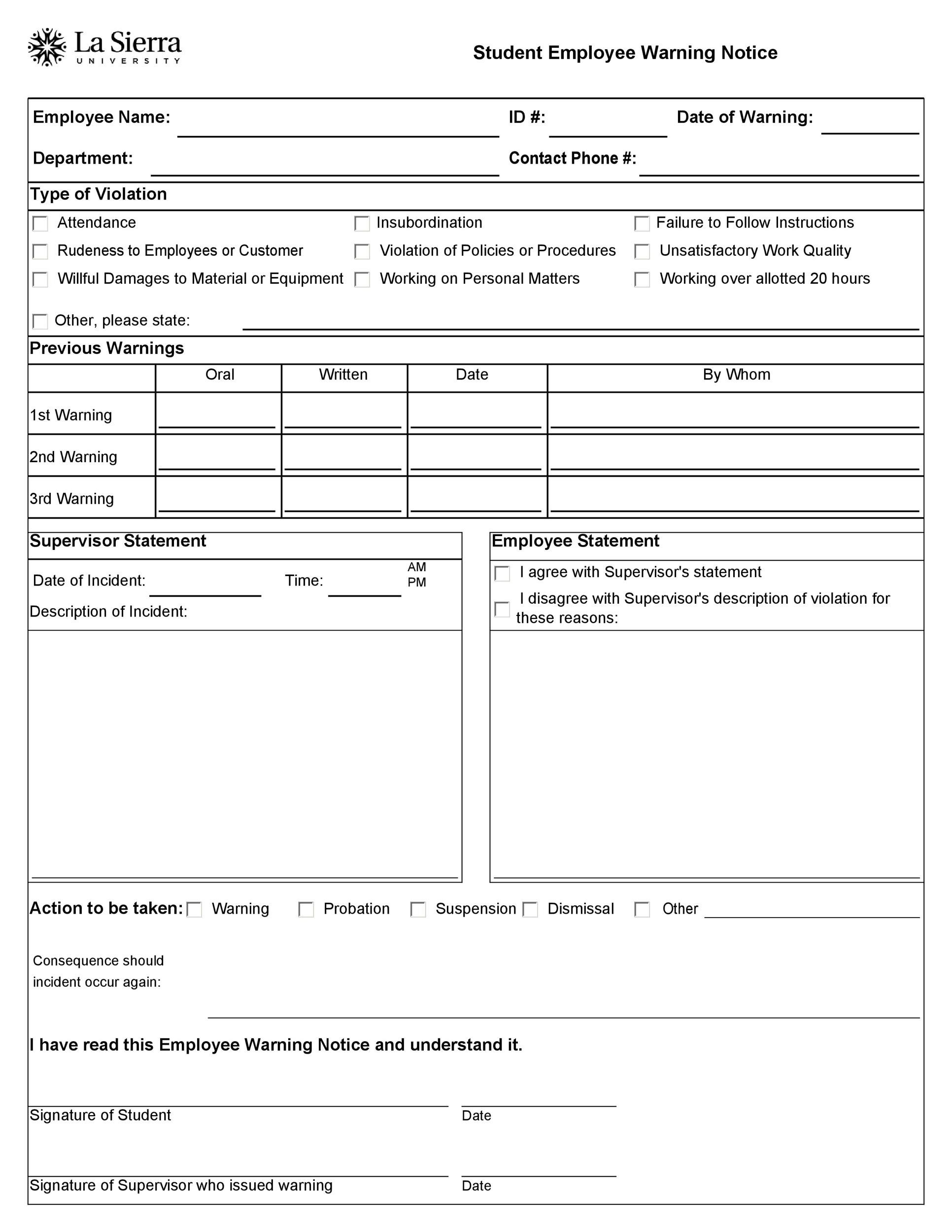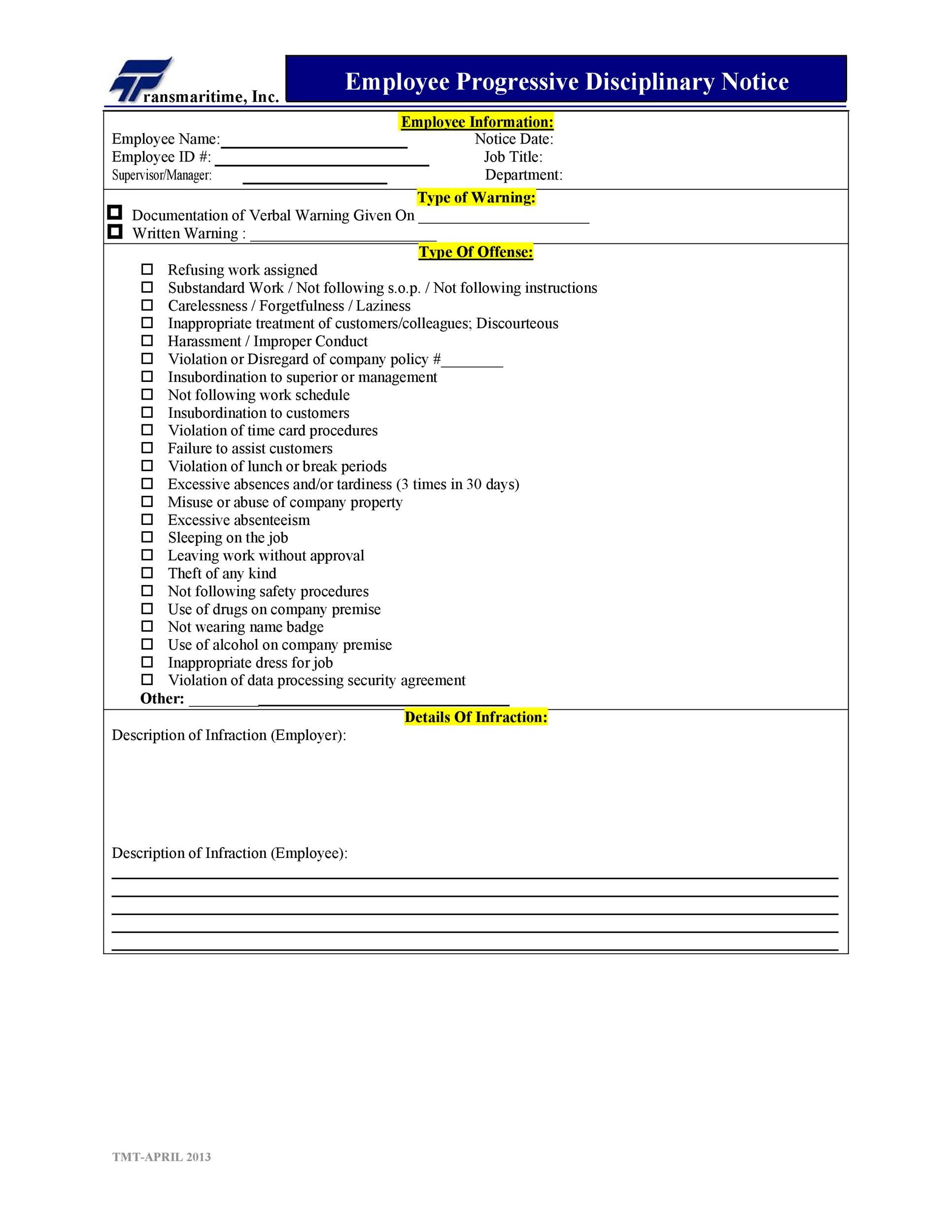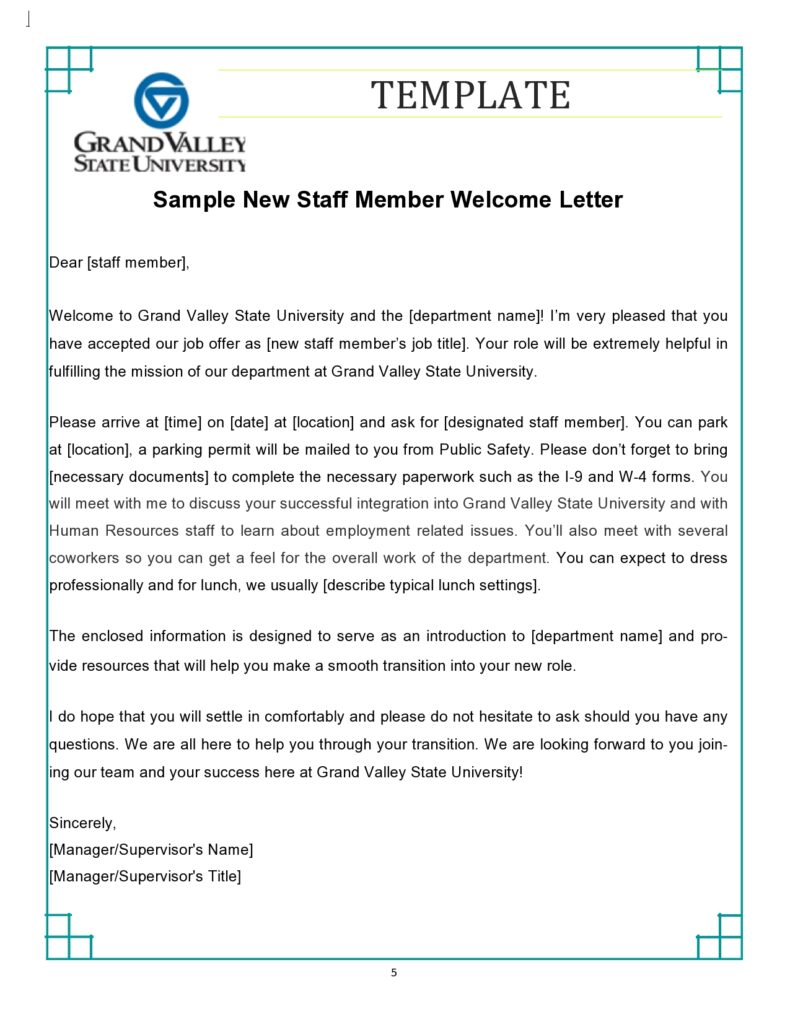An employee warning notice is a document which is mainly used in organizations by business management or HR departments in the process of disciplining employees. Such a document would include an outline of the type of warning the employee is to receive as well as other relevant information.
Table of Contents
- 1 Employee Warning Notice Templates
- 2 Importance of Making and Giving Out an Employee Warning Notice
- 3 Employee Warning Notice Forms
- 4 Kinds of Misconduct which May Warrant an Employee Warning Notice
- 5 Printable Employee Warning Notice
- 6 When and How to Give an Employee Warning Notice
- 7 Warning Notice to Employee
- 8 Making an Employee Warning Notice Template
- 9 Employee Warning Notice Samples
In any organization, a filled up employee warning notice template would be used to inform any employees who have committed an error or any kind of misconduct about it and it would also contain information about the consequences of the said mistake or misconduct. When you are making an initial draft of such a notice, it would be essential to make use of a proper format as this is an official document in the organization. Having a good format would also help in conveying the seriousness of your message to the person who is receiving it.
Along with this warning, you should already have proper policies and procedures in place which would be part of the whole employee discipline process. This is important so that the right people would know how to handle the said document and when it is to be issued.
Employee Warning Notice Templates
Typically, employers would want to have a written record or documentation whenever any kind of misconduct happens in an office or organization, to protect both employee and employer. Having a concrete employee warning notice is important as the original document would be handed to the employee involved and a copy of it would be kept in his/her file for reference and documentation.
Having this kind of document would also be helpful as it would keep all parties involved and it would reduce the confusion on the side of the employer and the employee as well. This article talks about everything there is to know about this kind of document to help you and guide you in your own organization.
Importance of Making and Giving Out an Employee Warning Notice
It is very important to give out an employee warning notice before executing any corrective actions against the employee. This is so that the employee is well informed and the employer would be going through the right disciplinary procedures. Here are some important reasons why you should have such a document:
- It would not be right to start firing an employee when a mistake has been made. The employee might take legal action against you, especially if the offense wasn’t that serious. So instead, you can give a notice or a warning to inform your employer that you are aware of the offense and actions will be taken.
- Giving out such documents to employees could encourage them to start evaluating themselves. When an employee receives such a notice, he/she may start thinking about what offense was done and what can be done to correct or improve the situation.
- These documents are possibly the best initial corrective action you can possibly take. Handing out such a notice would ensure that the employee knows that he/she has made a mistake and it’s been noticed and noted. The employee would then come to an understanding that what he/she has done was wrong and should not be done again.
- Making and giving out such documents would aid in developing a good image of your company. When you more frequently fire employees immediately rather than warn them, you may get a reputation which is less than desirable. In reality, employees do appreciate it when they are corrected especially when it’s done in a professional way. It would give them the chance to improve themselves and in turn, your whole organization improves too.
- Handing out such notices such as this would be a good sign showing that you care for your employees. Your employees may not know that they had committed a mistake so when you inform them, they will realize it and see that you actually had noticed them and what they are doing. It gives the impression that you don’t just pass them by but you actually see them at the workplace.
- Giving out warnings should be your first course of action so that you don’t run the risk of losing good or excellent employees. Remember, everyone makes mistakes and giving this document would be as good as giving them a second (or third) chance.
As you can see, it’s really very important to give out such warnings or notices, for different reasons. To help you out further, let’s take a look at the different kinds of misconduct or offenses which may warrant such a warning.
Employee Warning Notice Forms
Kinds of Misconduct which May Warrant an Employee Warning Notice
Filling up employee warning notice templates and giving them to employees would just be one step in the whole process. Prior to that, you’d have to come up with the different actions or offenses which would need such a document. Here are some examples of those misconduct or offenses, you may use all of these or come up with your own list in your organization.
- Neglecting one’s duties and responsibilities
- Insubordination or refusing to follow the instructions of employers or superiors except in cases when the instructions might have negative effects on the health and safety of the employee.
- Immoral or indecent actions in the workplace.
- Conviction of any kind of felony or misdemeanor inside and out of the workplace.
- Consciously submitting false documents as records or falsification of reports, records, and documents in the workplace.
- Stealing or destroying any property belonging to the company or to any of the employees in the company.
- Deliberate careless behavior which could be dangerous to the employee or to other employees in the organization.
- Consuming any kind of alcoholic beverage while on duty or while inside the premises except during company events.
- Threatening, abusive or coercive actions towards another employee, staff member or client of the organization.
- Allowing unauthorized persons inside secure areas of the premises without just cause.
- Having too many absences or tardiness in a specific amount of time.
- Not starting work on time and leaving work early.
- Taking long breaks and not being in the assigned work area for long periods of time.
- Posting materials on walls or display boards without permission or defacing and/or removing any materials which are authorized by walls or display boards.
- Smoking in areas which are prohibited.
- Not reporting to work without informing one’s supervisor or any other person in the organization.
- Selling products, soliciting or collecting personal contributions from fellow employees while in the workplace.
- Participating in any kind of gambling inside the organization during working hours.
These are the most common offenses which usually warrant an employee warning notice. Most of them may apply to your organization while some might not and you can just omit them. Either way, you should come up with your own list and place them at the handbook or in a memo so that all your employees are informed and will expect a warning or a notice if they happen to commit them.
Printable Employee Warning Notice
When and How to Give an Employee Warning Notice
When you are planning to give an employee warning notice to one of your employees, you should know exactly when and how to do it. Here are some helpful guidelines for you to help you out when you encounter an employee who performs any kind of misconduct in the organization.
Decide when it’s time to give a warning to an employee. There is usually a process when incidents happen in the office. Typically verbal warnings are given first before written warnings or notices are handed to an employee.
In following this process, you will help your employee understand the gravity of the situation from the very first time the offense is committed. The usual process is as follows:
- verbal warning
- written warning
- final written warning
- termination
Follow the policies and procedures of your organization in terms of disciplining employees. Make sure you are within the procedures and if you’re not sure, consult with your HR department or someone with a higher position that you. This is to ensure that you’re doing the right thing by giving a warning or notice to an employee.
Before you even start to write the warning or will up the template, collect all the information you can about the incident and the employee. In doing this, you would know exactly what happened and exactly what the employee did. Some relevant details would include (but are not limited to):
- date and time the offense was done
- details such as conversations and previous warnings which have been given to the employee
- previous written warnings which have been given to and signed by the employee regarding the same issue or a different offense
Have your own conversation with the employee in question. Doing this would allow you to gain a better understanding of what had transpired, from other sources and from the person who had actually committed the offense. In having a conversation with the employee, you would also be able to gauge whether you would be issuing an actually written warning or just giving a verbal one.
Consider whether it is actually your duty to write and/or issue the warning to the employee. More frequently in larger organizations, it may not be clear who should be writing or issuing the warning, especially in cases when the employee has more than one supervisor, officer or manager. Check the company policy to see who exactly should be handing out the notice.
Usually, the direct supervisor will have the task but there may be cases when the decision to issue such a document would be made in a group meeting.
If you’ve established that you will be writing the notice, then be sure to include all the relevant information. You would either have to write the information on a form or come up with a warning yourself, just be sure to write down the following:
- the name/s of everyone involved
- the nature of the offense which was committed
- all the relevant details of the warning, such as the dates and times
- corrective actions for the employee to do to rectify the situation
- consequences of the offense and any future consequences in case the offense happens again
Be very specific in writing the details of the warning. Doing this would ensure that all the information which is passed around is accurate and all the people who will be reading the notice is well informed.
All your statements have to be clear so that nothing will be interpreted in the wrong way. From the incident to the corrective actions to the consequences, everything should be stated clearly and well.
Make sure to issue the warning to the employee personally. Set a private meeting with the employee in question at the soonest possible time. When you do meet with the employee, talk about the offense and the consequences but also try to give positive feedback as well.
Giving positive feedback would have a good effect on the employee and may even encourage him/her to take immediate action in terms of correcting the mistake and becoming a more productive member of the workforce. Having such a meeting which is just focused on the offense might not be very productive as your employee might end up feeling really bad at the end of the meeting.
Before ending the meeting, make sure that the employee has understood everything which was written on the warning and everything you have spoken about during the meeting. It would be pointless to issue the warning and have the meeting only to realize that the employee didn’t actually understand everything fully and would most likely commit the offense again.
- Before giving the document to the employee, have him/her sign in first and have the employer sign it too. Then you would give the original document to the employee and keep a copy in his/her file.
- Finally, allow the employee to dispute the information on the warning if anything is inaccurate or he/she doesn’t agree with what’s written. As long as the employee has a good reason, of course. Then you can include the dispute or the statement in the document.
There you have it! Now that you’re armed with some good tips to guide you, you can start writing an effective employee warning notice and issue it to the right employee. Now let’s move on to actually making the notice.
Warning Notice to Employee
Making an Employee Warning Notice Template
To be able to make a good employee warning notice form or template, you’d have to include some very important elements. You can either search online for templates and either use or edit them or make your own from scratch and fit it into your own organization’s style. It’s all up to you. To guide you, we’ve come up with some useful steps and tips in making such a template.
Open the software of your choice and set the page size and margins. Also set the font style and size, keeping in mind that this is an official document. So it would be a good idea to use more formal fonts rather than fun or cursive fonts which might be harder to understand.
These are steps and tips for a template with 3 sections. Again, you can follow this template or revise it if you think that some of the sections aren’t applicable to your own organization.
- For the first section, you would have to insert the title of your document. Use a larger font to emphasize the title and you can format it the way you want, usually, it’s also written in a bold font.
- Under the title, include a space for the employee’s name. Make sure to write the full name of the employee since this is an official document for your company. You can also include a space for the employee’s job title or the position of the employee in the company.
- Under that, you can make a checklist of different offenses and place a blank square in front of each of the items. Doing this would make it a lot easier for the person who will be filling up the form. Make sure to include an “Others” option, with a blank space to specify the offense if it doesn’t appear in the list.
- For the second section, you can write a subheading to serve as the title for the previous warnings, if any. You can create a table or just format the parts in different columns. On the first column, write down first, second or third warning. On the second column, indicate if the warning given was oral or written. On the third column, the date of the warning would have to be placed and in the fourth column, write the name of the person who gave the warning.
- Under these columns, you can place a space for the statement of the employer, including the date and time the statement was given. Make sure to put a good amount of space for the employer to write his/her statement in full detail.
- Next, to the employer statement, you can place a space for the employee’s statement regarding the offense. To make it simpler, you can just place a box next to a declaration like “I agree with my employer’s statement” and another box next to another declaration such as, “I don’t agree with my employer’s statement regarding my violation” so all the employee would have to do is check the appropriate box.
- Under that declaration, place some blank spaces for the employee to write down his/her own account of the offense or of what had happened, in his/her own words.
- For the last section, you’d have to first place a subheading to serve as the title for the action to be taken. Again you can just place boxes to tick to make it easier and place an “Others” option with a blank to specify the action.
- Under the options, you can place a space for corrective actions to be taken. The person who would fill up the template would have to write down the actions to be taken in detail, especially if he/she won’t be the one to execute the actions.
- Then you should place a space for what consequences would be taken should the employee commit the offense again. This is very important so the employee knows what would happen if he/she does the same mistake twice.
- Under this part, you should include a declaration stating that the employee understood all the contents of the form and agrees with everything that is written.
- Then, place a space for the name and signature of the employee as well as the date the notice was accepted.
And finally, place a space for the name and signature of the employer as well as the date he/she signed the document. All these would make for an effective employee warning notice template.


